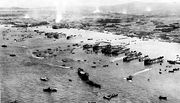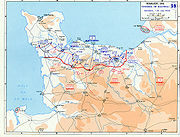
Beachhead
Encyclopedia


Military
A military is an organization authorized by its greater society to use lethal force, usually including use of weapons, in defending its country by combating actual or perceived threats. The military may have additional functions of use to its greater society, such as advancing a political agenda e.g...
term used to describe the line created when a unit (by sea) reaches a beach, and begins to defend that area of beach, while other reinforcements (it is hoped) help out, until a unit large enough to begin advancing has arrived. It is sometimes used interchangeably (both correctly and incorrectly) with Bridgehead
Bridgehead
A bridgehead is a High Middle Ages military term, which antedating the invention of cannons was in the original meaning expressly a referent term to the military fortification that protects the end of a bridge...
and Lodgement
Lodgement
A lodgement is an enclave taken by and defended by force of arms against determined opposition made by increasing the size of a bridgehead, beachhead or airheadOxford English Dictionary lodgement, lodgment "3. The action of establishing oneself or making good a position on an enemy's ground, or...
. Beachheads were very important in operations such as Operation Neptune
Operation Neptune
The Normandy landings, codenamed Operation Neptune, were the landing operations of the Allied invasion of Normandy, in Operation Overlord, during World War II. The landings commenced on Tuesday, 6 June 1944 , beginning at 6:30 AM British Double Summer Time...
, the Korean War
Korean War
The Korean War was a conventional war between South Korea, supported by the United Nations, and North Korea, supported by the People's Republic of China , with military material aid from the Soviet Union...
(especially at Inchon
Battle of Inchon
The Battle of Inchon was an amphibious invasion and battle of the Korean War that resulted in a decisive victory and strategic reversal in favor of the United Nations . The operation involved some 75,000 troops and 261 naval vessels, and led to the recapture of the South Korean capital Seoul two...
), and the Vietnam War
Vietnam War
The Vietnam War was a Cold War-era military conflict that occurred in Vietnam, Laos, and Cambodia from 1 November 1955 to the fall of Saigon on 30 April 1975. This war followed the First Indochina War and was fought between North Vietnam, supported by its communist allies, and the government of...
, among many other examples.
Although many references state that Operation Neptune refers to the naval operations in support of Operation Overlord
Operation Overlord
Operation Overlord was the code name for the Battle of Normandy, the operation that launched the invasion of German-occupied western Europe during World War II by Allied forces. The operation commenced on 6 June 1944 with the Normandy landings...
, the most reliable references make it clear that Overlord refers to the establishment of a large-scale lodgement
Lodgement
A lodgement is an enclave taken by and defended by force of arms against determined opposition made by increasing the size of a bridgehead, beachhead or airheadOxford English Dictionary lodgement, lodgment "3. The action of establishing oneself or making good a position on an enemy's ground, or...
in Normandy, and that Neptune refers to the landing phase which created the beachhead; i.e. Neptune was the first part of Overlord. According to the D-day museum:
The beachheads were named Utah, Gold, Sword, Omaha and Juno beaches.
Once an amphibious assault
Amphibious warfare
Amphibious warfare is the use of naval firepower, logistics and strategy to project military power ashore. In previous eras it stood as the primary method of delivering troops to non-contiguous enemy-held terrain...
starts, victory tends to go to the side which can reinforce the beachhead most quickly. There are exceptions to this rule where the amphibious forces have not expanded from their beachheads quickly enough to create a lodgement area before the defenders can reinforce their positions. Two famous examples in which the attackers failed to expand their beachheads before the defending side could bring up reinforcements occurred during the landing at Suvla Bay
Landing at Suvla Bay
The landing at Suvla Bay was an amphibious landing made at Suvla on the Aegean coast of Gallipoli peninsula in the Ottoman Empire as part of the August Offensive, the final British attempt to break the deadlock of the Battle of Gallipoli...
in the Gallipoli Campaign in World War I
World War I
World War I , which was predominantly called the World War or the Great War from its occurrence until 1939, and the First World War or World War I thereafter, was a major war centred in Europe that began on 28 July 1914 and lasted until 11 November 1918...
, and the amphibious landing at Anzio
Operation Shingle
Operation Shingle , during the Italian Campaign of World War II, was an Allied amphibious landing against Axis forces in the area of Anzio and Nettuno, Italy. The operation was commanded by Major General John P. Lucas and was intended to outflank German forces of the Winter Line and enable an...
during World War II
World War II
World War II, or the Second World War , was a global conflict lasting from 1939 to 1945, involving most of the world's nations—including all of the great powers—eventually forming two opposing military alliances: the Allies and the Axis...
.

